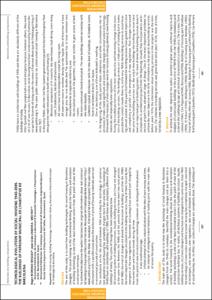Mostra el registre d'ítem simple
Technological evolution of social housing 1940-2005 : the buildings of Patronat Municipal de l’Habitatge de Barcelona
| dc.contributor.author | Moreno Mejías, Roger |
| dc.contributor.author | Zamora i Mestre, Joan-Lluís |
| dc.contributor.other | Universitat Politècnica de Catalunya. Departament de Construccions Arquitectòniques I |
| dc.date.accessioned | 2014-01-29T16:14:21Z |
| dc.date.available | 2014-01-29T16:14:21Z |
| dc.date.created | 2013 |
| dc.date.issued | 2013 |
| dc.identifier.citation | Moreno, R.; Zamora, J. Technological evolution of social housing 1940-2005 : the buildings of Patronat Municipal de l’Habitatge de Barcelona. A: World Congress on Housing Science. "39th IAHS Changig needs, adapative buildings, smart cities". Milano: PoliScript, 2013, p. 330-334. |
| dc.identifier.isbn | 9788864930138 |
| dc.identifier.uri | http://hdl.handle.net/2117/21399 |
| dc.description.abstract | The aim of this study is the evolution of the construction technology of the social hous-ing in Barcelona. The social housing in the conventional thinking about the history and evolution of building technology is one of the least innovative sectors from the point of view of the construction technique. To achieve that objective the author had searched original information about real con-structed buildings in the project files of the Patronat Municipal de l’Habitatge de Barce-lona (http://www.pmhb.org) from the ’40 in XX century to nowadays. Afterwards he had compared this case study information with a parallel study about price’s evolution came out in economical journals of construction. The conclusions are that during period between 1940’s till today the technology of construction applied to social housing has completely changed more than one time. The buildings of 1940’s have no similarities with buildings of 1980’s and these are abso-lutely different of today’s buildings. Two completely cycles of change have been completely done. All technical systems of building (structure, façade, installations,...) haven’t changed at the same time. Between the 1940’s and the present there have been two main periods: Until 1980’s the most of changes are placed in the structure of buildings and after the 1980’s the most important changes are placed in the installations of buildings, many of them forced by the emergence of the new regulations. Pavements and coatings have evolved and changed by the market laws and fashion trends during all time. From the point of view of construction technology someone can distinguish three phas-es: -a neo-traditional stage -a failed attempt of mass industrialization with the idea of earn money and time -an attempt of intelligent industrialization of building parts with the main idea of assure the quality. |
| dc.format.extent | 5 p. |
| dc.language.iso | eng |
| dc.publisher | PoliScript |
| dc.subject | Àrees temàtiques de la UPC::Edificació::Aspectes socials |
| dc.subject.lcsh | Public housing |
| dc.subject.other | Social housing |
| dc.subject.other | Building technology |
| dc.subject.other | Construction history |
| dc.subject.other | Barcelona |
| dc.subject.other | Patronat Municipal de l’Habitatge de Barcelona |
| dc.title | Technological evolution of social housing 1940-2005 : the buildings of Patronat Municipal de l’Habitatge de Barcelona |
| dc.type | Conference report |
| dc.subject.lemac | Habitatge públic |
| dc.contributor.group | Universitat Politècnica de Catalunya. LiTA - Laboratori d'Innovació i Tecnologia en l'Arquitectura |
| dc.rights.access | Open Access |
| local.identifier.drac | 12998703 |
| dc.description.version | Postprint (published version) |
| local.citation.author | Moreno, R.; Zamora, J. |
| local.citation.contributor | World Congress on Housing Science |
| local.citation.pubplace | Milano |
| local.citation.publicationName | 39th IAHS Changig needs, adapative buildings, smart cities |
| local.citation.startingPage | 330 |
| local.citation.endingPage | 334 |


